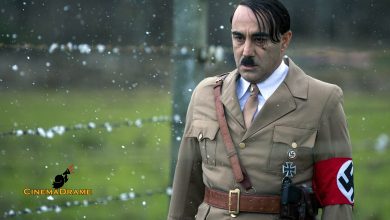Loghman Madayen’s Critique of Guillermo del Toro and Mark Gustafson’s Controversial Animated Film Pinocchio: The Story of a Father Whose Son Becomes a Missile Victim!

According to cinemadrame News Agency, Loghman Madayen, a film critic, dedicated an exclusive note to reviewing Guillermo del Toro and Mark Gustafson’s controversial animated film Pinocchio, writing: The animated film Pinocchio, directed by Guillermo del Toro and Mark Gustafson, written by del Toro and Patrick McHale, and based on Grace Grimly’s concept derived from the 2002 version of Carlo Collodi’s 1883 Italian novel The Adventures of Pinocchio, was released.
Right from the start, this animation diverges from the original Pinocchio narrative, transporting it into the setting of World War I and Mussolini’s Fascist regime, attempting to speak to its new generation of audience members.
The story begins with Geppetto, the carpenter, witnessing his son Carlo being killed by an air-to-ground missile, plunging him into years of grief.
The film aims to convey that when Geppetto comes to terms with his sorrow, he doesn’t rise up in revenge against Mussolini’s dictatorial regime, doesn’t wage war against religion, and doesn’t endanger others’ lives. He observes how Fascist agents have infiltrated the populace, how temples are controlled by the dictatorship, how religious opportunism is rampant. He sees people accustomed to their totalitarian government, having found a common taste, and if not actively supporting its warmongering policies, at least remaining silent. He witnesses the pervasive corrupt culture in society, how the oppressive regime, by propagating lies, has deemed war a blessing and considered dying for its destructive policies an act of heroism. Through its media propaganda, it has stirred the emotions of adolescents and sent children to war.
So, he observes all this, transforms his anger and sorrow into energy, and dedicates all his artistry to creating a figure from wood, named Pinocchio, who embodies his son Carlo.

In a world promoting atheism, the film speaks of God; in an era of religious aversion, it speaks of faith; and in the Buddhist Hollywood realm, which centers humanity and, relying on materialism, rejects the afterlife, it speaks of the existence of the soul and the world beyond death. Going a step further, it introduces God as the supporter of Geppetto’s action, tasking the Angel of Death with breathing life into Pinocchio. This is because God knows Geppetto had raised his son Carlo to be truthful and against war. Here, Pinocchio’s dialogue gains meaning when he stands with Geppetto before the statue of Christ (PBUH) and Pinocchio asks, “Why do people love this wooden statue but not me?” For us Muslims, this reflects verse 21 of Surah Al-Imran, which commentators like the late Ayatollah Taleghani explain as: those who did not hear or understand the call of the prophets, if they strive in the path of establishing justice (or the prophetic goals), God places their killers among the killers of prophets. This means that in a society devoid of meaning, Geppetto creates a Pinocchio who strives to oppose war and lies, fratricide, and establish justice. So, he unconsciously compares himself to the statue of Christ (PBUH) to clarify the goals of his mission. And again, our rich Iranian culture helps in understanding the subject better, as the great Ferdowsi says: “Faridun the glorious was no angel, nor molded from musk and ambergris; through justice and generosity he gained his goodness; you too be just and generous, and you are Faridun.” That is, the animation, by creating its unique Pinocchio character, aims to tell its new generation audience that if you too grasp these goals and apply them in life, you will be beloved like Christ (PBUH), for you have found God’s purposes.
So, Pinocchio comes to life and enters the world. Step by step, in our religious interpretation, like Abraham (PBUH) who saw the moon, sun, and stars and thought they were his God, and upon seeing their demise, realized they were not his deity, he undergoes the hero’s journey. He touches upon lies and realizes that lying is wrong, sees war and understands it is a destructive act, and observes injustice and comprehends that silence in its face is a form of slavery. He learns self-sacrifice, not for power-seeking interests, but for keeping his family, real friends, and loved ones alive. He learns that his victory is not necessarily dependent on another’s loss, and he learns that lying is only permissible in one instance: to save another’s life, which is again a specific teaching and an example of Imam Ali (PBUH)’s words for us Muslims.
Let’s move beyond its commendable content and delve into the form and screenplay.
The first inciting incident of the film is when Geppetto, by accepting his grief, transforms his sorrow into energy and creates Pinocchio. The wise fairy breathes life into him, the challenge begins, and the story takes shape.
The climax of the film is where Pinocchio, in the afterlife, decides to sacrifice himself and break his hourglass of life to return to his worldly body and save Geppetto’s life. There, he uncovers the great secret of life.
The second turning point of the film is when the wise fairy once again brings Pinocchio back to life, saving him from certain death, and normal life resumes.
The hero of the film is Pinocchio. It is he who, receiving teachings from Geppetto throughout his heroic journey, learns how to stand against oppression, establish justice, turn enemies into friends, not lie, and sacrifice for his family. In character psychology, based on Jungian theory, he embodies the Trickster archetype. Besides possessing elements of courage, determination, and strength, he tries to outwit, overcome obstacles, and achieve his goal through his specific mischiefs, constantly growing throughout his plot journey to reach the desired character transformation.
The antagonist is Count Volpe, the exploitative aristocrat skilled in puppetry and circus arts. By creating obstacles for Pinocchio, he separates him from school and leads him astray from his main path. He tries to make him a supporter of war, an ally of oppressors, and a liar, infringing upon his rights and attempting to enslave Pinocchio. In his character psychology, he also benefits from the Trickster archetype, but in its shadow aspect, meaning he tries to exploit others through audacity and deception.
Alongside the main plot, we witness subtle and well-executed subplots that intermittently delve into each character’s personal life at opportune moments.
The screenplay’s dialogue has many weaknesses: it’s not conflict-driven or mysterious, it’s verbose, not fluid, vague and lengthy. However, it is character-building, not revealing, doesn’t bombard with information, creates atmosphere, and pays attention to subplots.
Candlewick is initially an anti-value who, influenced by his father Podesta, sees life in fighting for Mussolini. However, after befriending Pinocchio, he transforms into a value and stands against his father to save his friend’s life.
The film’s mise-en-scène is excellent. It successfully portrays that specific historical period in animation: the house, the church, the open spaces, the barracks, or the circus. Furthermore, the clothes we see on common people, priests, security agents, and others indicate precise design that speaks of sufficient research into the customs and culture of that era. Most importantly, it possesses color psychology. For instance, when Geppetto reaches Pinocchio but there is no life left in him, the wise fairy appears and bathes them in blue light, a color symbolizing healing. Or Sebastian, who is navy blue, informing us of his emotional nature and humanitarianism. Or Geppetto’s olive-colored clothes, speaking of his emotional pain, his strength in enduring difficulties, and his character growth.
However, we see a serious weakness in the directing: the screenplay is unpolished, full of superfluous dialogue and scenes which, due to a lack of removal and professional editing, and incorrect shot arrangement, have dragged down the speed and rhythm. Yet, the placement, movement, and angle of the camera are very good; the lighting and sound are excellent, and it has a suitable soundtrack.
The voice actors’ artistry is most striking: the powerful vocal magic of David Bradley as Geppetto, Christoph Waltz as Count Volpe, and Cate Blanchett as Spazzatura has added to the appeal of this work.
Another serious weakness is the absence of powerful suspense, which prevents the audience from experiencing the thrill of surprise. A large part of this weakness might be attributed to the dialogue and unprofessional editing.







